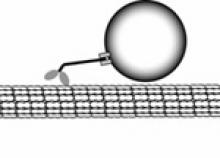
While most of us did not know we have motors in our bodies, they certainly play an important role. They are vital to our cells dividing and help keep the cells in good working order by moving things inside of our cells. The molecular motors activity will demonstrate how materials inside cells are transported.
The goal of this demonstration is to enable visitors to learn about the transport of materials inside the cell.
Materials needed:
- 4-6 home siding sheets
- 3-4 pairs of socks with CD cases attached
Procedure
- Connect the siding pieces by hooking the long, notched end of one piece of siding into the underside of the long, plain end. Place the siding on the floor.
- Have the participant put on the socks with the CD's on the ends. Do not have them pull the sock all the way up. The CD needs to be hanging down several inches.
During the demonstration
- Talk to the visitors about biological motors in the body (see FAQ sheet and reference for more information). These motors help to move important items inside of our cells. The biological motors move along tracks (like the siding you have on the floor) until they reach the place they need to go. Express to them, that in this activity, they are the motors responsible for transporting important items within the cell. Without these motors we could not survive.
- The motors and tracks are both made of proteins. Specific motors will only move on a certain type of track. One type of motor track system is kinesin and microtubules. The kinesin protein is the motor and the microtubules are the tracks. The microtubules are made a protein called tubulin.
- Have the visitors run their hands or feet across the siding tiles. They can easily slide their hands or feet in one direction, but in the other direction the ridges impede movement. In this way the track dictates the movement of the motor.
- Ask the participants to guess which was the motor will be able to move on the track. Then have them test their hypothesis using the motor socks.
- The picture on the CD is an actual depiction on a kinesin molecule cut in half (one side for each foot). The molecule is very complex.
Explanation
While most of us did not know we have motors in our bodies, they certainly play an important role. They are vital to our cells dividing and help keep the cells in good working order by moving things inside of our cells. The tracks dictate the movement of the motors, not the other way around. Without the high specialization of the tracks, the motors would move uncontrolled in every direction and proteins would not be sent to the correct receptors.
One example is when our cells divide in a process called mitosis they need to have a copy of everything that was in the original cell that divided. The tracks start at the center of the cell and move out in two opposite directions and carry the same cargo to each of the new cells. The motors will carry things such as DNA after replication to the new cells that are produced during the process of mitosis.
Scientists can attach the kinesin motors to a piece of glass so they can not move. The feet of the kinesin are sticking up in the air. A microtubule is placed on the motors. The feet of the kinesin push the microtubules along. It works just like a person who is body surfing!!! Scientists hope to attach cargo to the microtubules and use these motors to move very small cargo.
Procedure Sheet: molecular_motors_procedure.pdf
Molecular Motors FAQs
Did you know inside our bodies are little motors that carry cargo inside of our cells? That is right our bodies have biological motors. These motors help to move important items inside of our cells. The motors move along tracks inside of our cells, the tracks start at the center of our cells and grow outward. The biological motors move along until they reach the place they need to go.
Cool Facts
- There are trillions and trillions of little motors in your body right now!!
- Our bodies contain many different types of motors, some work like trains moving on straight tracks, while others move in circles.
- The biological motors are 5 times more efficient than any motors humans can make on the same scale.
- Scientist have taken these motors out of our bodies and making them do work for us!!
FAQs
A: The motors and tracks are both made of proteins. Specific motors will only move on a certain type of track. One type of motor track system is kinesin and microtubules. The kinesin protein is the motor and the microtubules are the tracks. The microtubules are made a protein called tubulin.
A: When our cells want to move cargo from the center of the cell to the outer portions the cells produce tracks. In the kinesin based motor system the tracks grow by adding individual tubulin proteins to the growing tracks.
A: In the kinesin microtubule motor system the kinesin walks along the microtubule. The kinesin has feet that attach to the microtubule one at a time. After one foot attaches the other moves forward, the kinesin will do this until it reaches its destination.
A: One example is when our cells divide in a process called mytosis they need to have copy of everything that was in the original cell that divided. The tracks start at the center of the cell and move out in two opposite directions and cary the same cargo to each of the new cells. The motors will carry things such as DNA after replication to the new cells that are produced during the process of mytosis.
A: One example occurs when scientists attach the kinesin motors to a piece of glass so they can not move. The feet of the kinesin are sticking up in the air. A microtubule is placed on the motors. The feet of the kinesin push the microtubules along. It works just like a person who is body surfing!!! Scientists hope to attach cargo to the microtubules and use these motors to move very small cargo.
While most of us did not know we have motors in our bodies, they certainly play an important role. They are vital to our cells diving and help keep the cells in good working order by moving things inside of our cells.

